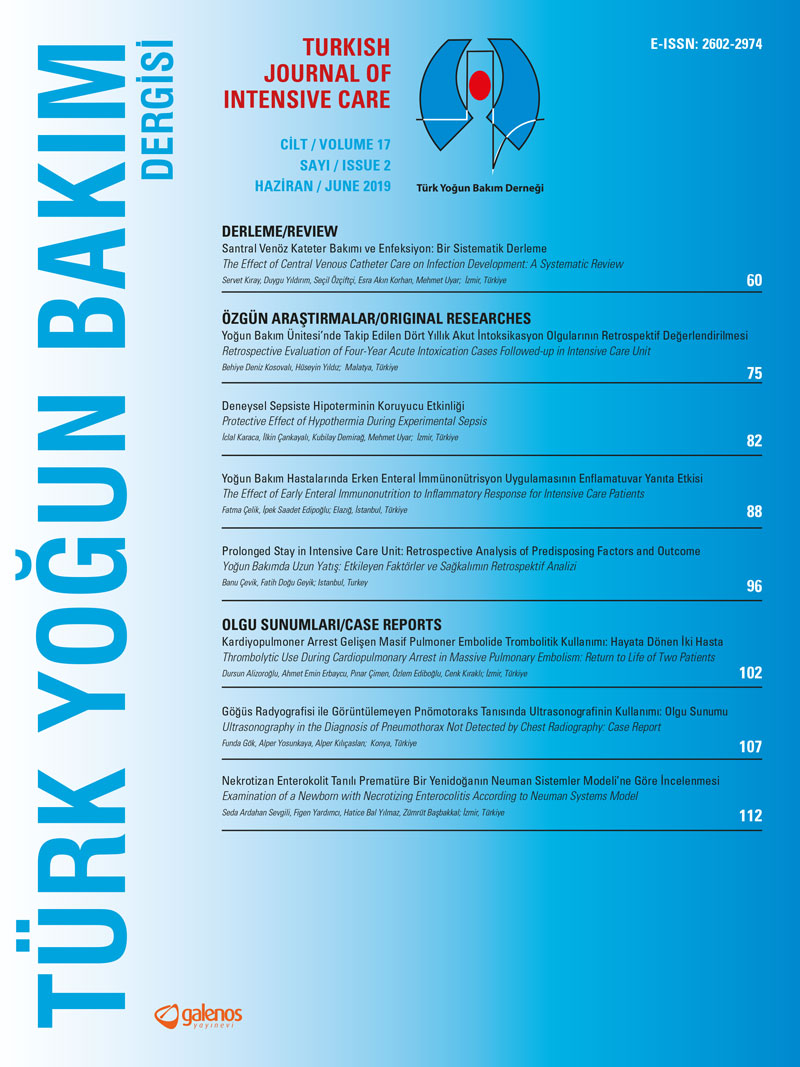Öz
Pulmoner emboli teşhisi halen zordur, çünkü farklı semptom ve bulgular ile seyredebilmektedir. Bu olgular acil servislere şok, senkop veya kardiyopulmoner arrest ile gelebilmektedir. Kardiyopulmoner arrestlerin %70’inden fazlası akut miyokard infarktüsü veya masif pulmoner emboli nedeniyle ortaya çıkmaktadır ve prognoz kötüdür.
Bu yazıda kardiyopulmoner resüsitasyon (CPR) gerektiren ve trombolitik ajan uygulanan masif pulmoner embolili iki hasta sunulmuştur. Hastalara 10 mg bolus şeklinde rekombinant doku tip plazminojen aktivatörü (alteplaz) uygulanmış ve ardından iki saat boyunca 90 mg intravenöz infüzyona devam edilmiştir. Trombolitik verilmesi sonrasında hızlı klinik ve hemodinamik iyileşme tespit edilmiş ve hastalar düzelme sonrasında hastaneden taburcu edilmiştir.
Kardiyopulmoner arrest gelişen hastalarda eğer altta yatan hastalığın masif pulmoner emboli olduğundan şüpheleniliyor ise, CPR ile birlikte trombolitik ajanlar da uygulanmalıdır. Bu prosedür, arrestin neden olduğu durumu tedavi edecek ve erken mikrodolaşım, serebral perfüzyonu iyi yönde etkileyecek ve nörolojik sekel oluşumunu engelleyecektir
Anahtar Kelimeler: Pulmoner emboli, kardiyopulmoner arrest, resüsitasyon, alteplaz
Referanslar
- Bailén MR, Cuadra JA, Aguayo De Hoyos E. Thrombolysis during cardiopulmonary resuscitation in fulminant pulmonary embolism: a review. Crit Care Med 2001;29:2211-9.
- Jaff MR, McMurtry MS, Archer SL, et al. Management of massive and submassive pulmonary embolism, iliofemoral deep vein thrombosis, and chronic thromboembolic pulmonary hypertension: a scientific statement from the American Heart Association. A scientific statement from the American Heart Association. Circulation 2011;123:1788-830.
- Truhlář A, Deakin CD, Soar J, et al. European Resuscitation Council Guidelines for Resuscitation 2015: Section 4. Cardiac arrest in special circumstances. Resuscitation 2015;95:148-201.
- Martin C, Sobolewski K, Bridgeman P, et al. Systemic Thrombolysis for Pulmonary Embolism: A Review. P T. 2016;41:770-5.
- Chatterjee S, Chakraborty A, Weinberg I, et al. Thrombolysis for pulmonary embolism and risk of all-cause mortality, major bleeding, and intracranial hemorrhage: a meta-analysis. JAMA 2014;311:2414-21.
- Peters NA, Paciullo CA. Alteplase for the Treatment of Pulmonary Embolism: A Review. Adv Emerg Nurs J 2015;37:258-72.
- Konstantinides S, Geibel A, Heusel G, et al. Heparin plus alteplase compared with heparin alone in patients with submassive pulmonary embolism. N Engl J Med 2002;347:1143-50.
- Uçar EY. Thrombolitic treatment. Türkiye Klinikleri J Pulm Med-Special Topics 2016;9:39-43.
- O’Connor G, Fitzpatrick G, El-Gammal A, et al. Double Bolus Thrombolysis for Suspected Massive Pulmonary Embolism during Cardiac Arrest. Case Rep Emerg Med 2015;2015:367295.
- Curtis GM, Lam SW, Reddy AJ, et al. Risk factors associated with bleeding after alteplase administration for pulmonary embolism: a case-control study. Pharmacotherapy 2014;34:818-25.
- Virk HUH, Chatterjee S, Sardar P, et al. Systemic Thrombolysis for Pulmonary Embolism: Evidence, Patient Selection, and Protocols for Management. Interv Cardiol Clin 2018;7:71-80.
- Smithburger PL, Campbell S, Kane-gill SL. Alteplase treatment of acute pulmonary embolism in the intensive care unit. Crit Care Nurse 2013;33:17-27.
- Hasanoglu HC. Thrombolitic treatment: Who, when, how? Guncel Gogus Hastaliklari Serisi 2015;3:34-44.
- Böttiger BW, Arntz HR, Chamberlain DA, et al. Thrombolysis during resuscitation for out-of-hospital cardiac arrest. N Engl J Med 2008;359:2651-62.
- Condliffe R, Elliot CA, Hughes RJ, et al. Management dilemmas in acute pulmonary embolism. Thorax 2014;69:174-80.
Telif hakkı ve lisans
Telif hakkı © 2019 Yazar(lar). Açık erişimli bu makale, orijinal çalışmaya uygun şekilde atıfta bulunulması koşuluyla, herhangi bir ortamda veya formatta sınırsız kullanım, dağıtım ve çoğaltmaya izin veren Creative Commons Attribution License (CC BY) altında dağıtılmıştır.






















